Difference between revisions of "Paul Mlakar"
(DSF) |
|||
| Line 19: | Line 19: | ||
===Murrah Building, Oklahoma City, 1995=== | ===Murrah Building, Oklahoma City, 1995=== | ||
{{FA|Oklahoma City bombing}} | {{FA|Oklahoma City bombing}} | ||
| − | Paul Mlakar worked under [[Charles Thornton]], (together with [[Gene Corley]] and [[Mete Sozen]]) on the collapse of the Murrah Building in [[Oklahoma | + | Paul Mlakar worked under [[Charles Thornton]], (together with [[Gene Corley]] and [[Mete Sozen]]) on the collapse of the Murrah Building in [[Oklahoma City]]. |
===WTC, 9-11=== | ===WTC, 9-11=== | ||
Revision as of 20:42, 18 December 2019
(engineer, deep state functionary) | |
|---|---|
 | |
| Alma mater | West Point, Purdue University |
An engineer who has signed off on a number of "investigations" for the US deep state. | |
Paul F. Mlakar, Ph.D., P.E., F.ASCE. of the US Army Corps of Engineers (USACE) is a NATO-connected academic and deep state functionary. He is notable for his work on investigation of a number of disasters, including the 9-11 attacks, the Oklahoma City bombing and the failure of the levees in New Orleans after Hurricane Katrina.
Contents
Background
"Mlakar graduated from West Point and subsequently earned an M.S. and a Ph.D. in Engineering Science from Purdue University."[1]
Activities
"In the winter of 1996, Dr. Mlakar was the Chief Engineer of a North Atlantic Treaty Organization Task Force that rapidly restored a critical, war-damaged, century-old bridge on the main line of supply for Operation Joint Endeavor in Bosnia."[1]
"Investigations"
Mlakar's investigations have been widely criticized by a number of independent investigators, and he has a remarkable continuity of co-workers.
Murrah Building, Oklahoma City, 1995
- Full article: Oklahoma City bombing
- Full article: Oklahoma City bombing
Paul Mlakar worked under Charles Thornton, (together with Gene Corley and Mete Sozen) on the collapse of the Murrah Building in Oklahoma City.
WTC, 9-11
- Full article: 9-11/WTC Controlled demolition
- Full article: 9-11/WTC Controlled demolition
Mlakar, again with Mete Sozen under Gene Corley, developed an explanation of the collapse of the World Trade Center which denied the evidence of bombs in the buildings and suggested that the three towers collapses as a result of the two plane impacts.
Pentagon, 9-11
- Full article: 9-11/Pentagon
- Full article: 9-11/Pentagon
As Lead Technical Director, Mlakar headed the six-member Pentagon Building Performance Study team after 9-11, which also included Mete Sozen.[2][3] Mlakar is granted “limited access” to the Pentagon attack site for a week from September 14-21, and on October 4, the full team is given "controlled access". They meet Gene Corley and inspect the site "for approximately four hours." All airplane debris has been removed by this time, as well as most of the loose debris from the impact and collapse. Along with interviews and technical information provided by the Pentagon Renovation Project, the photos and data gleaned on these visits are the basis of the team’s analysis of the building’s response to the impact of Flight 77. The study is completed in April 2002, though the report will not be released for another nine months.[4]
Hurricane Katrina
Mlakar lead the Army Corps of Engineers' investigation into the breakage of levees in New Orleans after Hurricane Katrina.[5] Professor Raymond B. Seed of the of the UC Berkeley department of Civil and Environmental Engineering wrote a powerful and detailed 42 page letter alleging corruption, connivance, collusion, obfuscation, retaliation etc.
"...Larry Roth had explained to me back in early September that ASCE had been ingloriously kicked out from the 911 investigation of the World Trade Center, and that they had learned their lesson and would never again make those same mistakes... ...What he meant was that a non disclosure clause that had been inserted into ASCE’s health and safety waiver/form for forensic investigations... ...Buried...was a very strong and binding non-disclosure clause..."[6]
References
- ↑ a b https://www.naocon.org/members/paulmlakar/
- ↑ http://fire.nist.gov/bfrlpubs/build03/PDF/b03017.pdf
- ↑ http://web.archive.org/web/20100313002041/http://www.terrorisminfo.mipt.org/Oklahoma-City-Bombing.asp
- ↑ http://www.historycommons.org/entity.jsp?entity=paul_mlakar_1
- ↑ http://articles.latimes.com/2005/oct/08/nation/na-levee8
- ↑ http://aquadoc.typepad.com/files/katrina_and_soul_of_the_profession.pdf